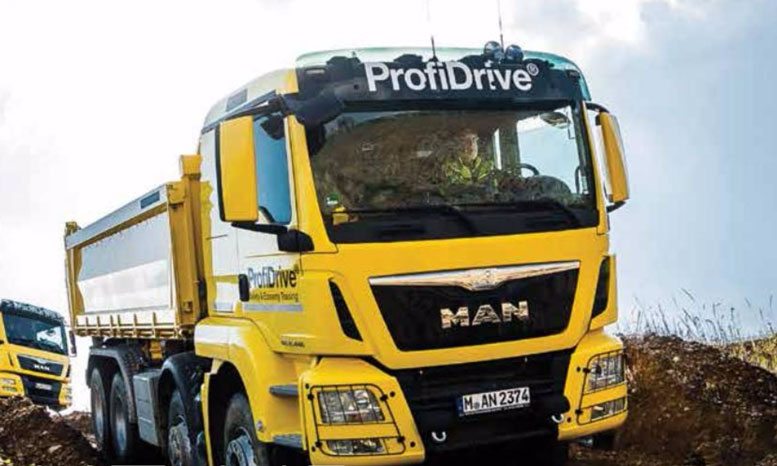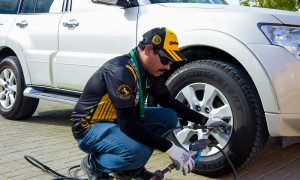Wake up to truck safety: Strategies for Gulf fleet operators
MAN Safety Event highlights the risks of tired driving and tyres

Since emerging as a major force in the GCC at the turn of the decade, MAN Truck and Bus Middle East has placed safety training at the forefront of its strategy in the market.
It recently held its first ever Road Safety Event in Abu Dhabi in collaboration with the police authority in the UAE capital as well as RoadSafetyUAE, one of the country’s leading campaigners for, as the name suggests, road safety.
During the event, representatives from both the private and public sector were presented with a compelling and educational overview of how they can help the UAE to continue on its aim of reducing its road fatalities to three deaths per 100,000 population annually by 2021.
According to MAN Truck and Bus Middle East’s managing director Franz Freiherr von Redwitz there is no one size fits all approach to saving lives on the road.
Instead there needs to be adherence to regulations, greater education and better use of the technology that is available.
On the latter, the latest MAN vehicles include a series of features designed to reduce the likelihood of something going perilously wrong on the road.
It has worked extensively on its active and passive systems on-board its trucks such as: Electronic Damping Control (EDC) to improve safety and handling; Electronic Stability Program (ESP) to limit accidents caused by overturning (its dynamic steering program prevents understeer by braking the inner rear wheel) or straying from the lane (its roll over prevention system reduces torque or brakes before the vehicle slides); and its Anti-Spin Regulator (ASR) provides assists to controlled braking).
He describes MAN Truck and Bus’ role goes beyond providing vehicles with state of the art safety features.
“With its global expertise in the field of vehicle safety and road safety, MAN can contribute in a number of ways in enhancing road safety in the UAE – such as supporting the introduction of road transport regulations, providing training and education for transport operators and enforcement officers, and supporting the introduction of mandatory vehicle specification standards for new product deliveries.”
The truck maker also has its own well-established ProfiDrive training programme which trains thousands of drivers and fleet managers globally every year. While it covers a huge series of topics, the focus of ProfiDrive is always on understanding the demands placed on the driver.
Looking at the Middle East, Franz Von Reditz argues that the driver should be the main concern, especially as he feels that drivers in the region drive are driving for long stretches and are “very tired.”
As he points out, correctly, that driver behind the wheel can turn a very safe and modern truck into a dangerous or hazardous truck. He adds, however, that most drivers can be turned into safer drivers when given the proper education.
“The driver can be educated, if it is done in a very good way he can make the vehicle safe,” he opines.
He adds that fleet owners and managers should take greater responsibility in improving driver safety.
“The impact of driver education and training on vehicle performance and safety is hugely underestimated in the region. As a result, many fleet owners are reluctant to invest in driver education.
He adds: “Also, there is a common misconception that the current situation can be changed solely by focusing on driver education and training. While driver education is of course hugely important, the driver basically executes what a supervisor or transport manager requires, so it is paramount that fleet owners and managers adopt a more proactive approach to safety.
“However, when it comes to accidents involving trucks, the results are usually deadly. For instance, a semi-trailer truck takes roughly three times more to stop than a car and hence one must never pull in front of a semi-trailer truck and brake abruptly.”
Much of the event in November explored the various road safety initiatives and programmes currently underway in the UAE. As well as providing its own insight, MAN provided two trucks for those at the event to learn how technology is re-shaping the safety aspects of its vehicles.
Franz Von Reditz was also given an opportunity at the event to highlight the dangers of driver fatigue and the importance of educating all road users. To him everyone on the road should understand the limitations and special considerations for stopping distances of trucks, the event was a much needed chance to show how different types of vehicles use the road differently.
All through the event, the message to fleet owners and operators was that they need to understand the benefits to their operation and other road users of proper monitoring and support for their drivers.
Franz Von Reditz and MAN understands that it will need to continue to bring together the commercial sector and other stakeholders if its campaign is to prove a long-term success.
“Through our safety campaign, we aim to highlight the top reasons that impact road safety from a commercial vehicle perspective such as load of the vehicle, driver alertness, worn tyres and incorrect/incomplete maintenance,” he explains. “It is an important step towards greater cross-stakeholder collaboration that will help make the country’s roads safer.
He continues: “MAN has an ongoing commitment to improving road safety and we will continue to offer support and expertise to help the UAE achieve its road safety targets. Targeted initiatives and campaigns aimed at raising road safety awareness and improving driver education are essential to achieving these goals. This will continue to be a focus for us moving forward.”
Truck safety – what do you need to know?
It is not only the gross vehicle weight that can affect safety. Load positioning and distribution too can have consequences for road safety, hence it important to know how to load your vehicle for safety. Severe overloading of the drive axle or under-loading of the trailer axle can adversely affect steering, braking and speed control.
Tyre suitability is a vital link in the load-to-road chain. Care must be taken to ensure that the maximum load rating for a tire is never exceeded.
Driver alertness is critical. If a driver has not slept in 17 hours, their driving ability is similar to a driver who is driving under the influence of alcohol. Today we have technology alternatives available – such as Tachographs – to monitor driver working hours which have a huge impact on accident rates. The Tachograph helps in enabling enforcement of rules related to drivers’ hours, and functions as an aid to road safety. Using a combined speedometer and clock, the Tachograph records automatically on a paper disc the vehicle’s speed, distance travelled, and time spent on the road, helping keep tired drivers off the roads.
When it comes to braking, having an understanding of the complete interrelationship of systems is important. Mismatch of tractor-trailer combinations can result in an unsafe vehicle in operation.
Maintenance has a large part to play in safety. Regular maintenance is essential to ensuring the safety of your vehicle and keeping it running at peak efficiency.
Intelligent technology solutions such as MAN TeleMatics can significantly contribute to enhancing vehicle safety and efficiency by providing drivers and fleet managers with essential data to optimise vehicle usage and plan services well in advance.





